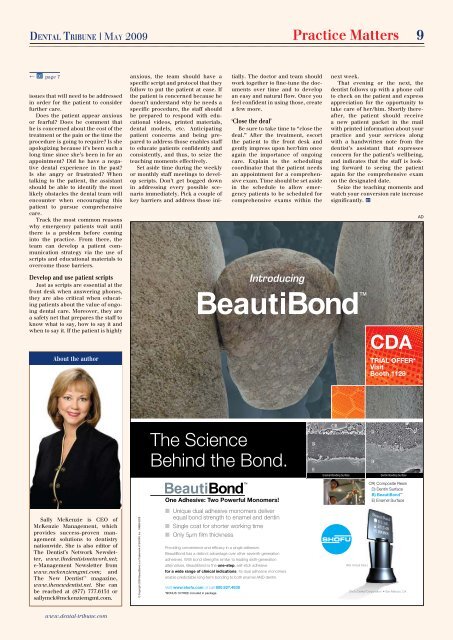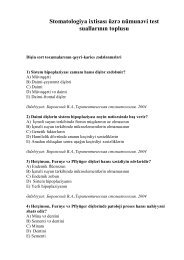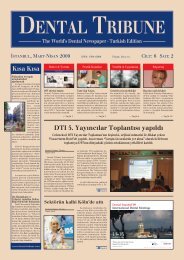DENTAL TRIBUNE
DENTAL TRIBUNE
DENTAL TRIBUNE
You also want an ePaper? Increase the reach of your titles
YUMPU automatically turns print PDFs into web optimized ePapers that Google loves.
<strong>DENTAL</strong> <strong>TRIBUNE</strong> | MAY 2009 Practice Matters 9<br />
� DT page 7 anxious, the team should have a<br />
specific script and protocol that they<br />
issues that will need to be addressed<br />
in order for the patient to consider<br />
further care.<br />
Does the patient appear anxious<br />
or fearful? Does he comment that<br />
he is concerned about the cost of the<br />
treatment or the pain or the time the<br />
procedure is going to require? Is she<br />
apologizing because it’s been such a<br />
long time since she’s been in for an<br />
appointment? Did he have a negative<br />
dental experience in the past?<br />
Is she angry or frustrated? When<br />
talking to the patient, the assistant<br />
should be able to identify the most<br />
likely obstacles the dental team will<br />
encounter when encouraging this<br />
patient to pursue comprehensive<br />
care.<br />
Track the most common reasons<br />
why emergency patients wait until<br />
there is a problem before coming<br />
into the practice. From there, the<br />
team can develop a patient communication<br />
strategy via the use of<br />
scripts and educational materials to<br />
overcome those barriers.<br />
Develop and use patient scripts<br />
Just as scripts are essential at the<br />
front desk when answering phones,<br />
they are also critical when educating<br />
patients about the value of ongoing<br />
dental care. Moreover, they are<br />
a safety net that prepares the staff to<br />
know what to say, how to say it and<br />
when to say it. If the patient is highly<br />
About the author<br />
Sally McKenzie is CEO of<br />
McKenzie Management, which<br />
provides success-proven management<br />
solutions to dentistry<br />
nationwide. She is also editor of<br />
The Dentist’s Network Newsletter,<br />
www.thedentistsnetwork.net;<br />
e-Management Newsletter from<br />
www.mckenziemgmt.com; and<br />
The New Dentist magazine,<br />
www.thenewdentist.net. She can<br />
be reached at (877) 777.6151 or<br />
sallymck@mckenziemgmt.com.<br />
www.dental-tribune.com<br />
follow to put the patient at ease. If<br />
the patient is concerned because he<br />
doesn’t understand why he needs a<br />
specific procedure, the staff should<br />
be prepared to respond with educational<br />
videos, printed materials,<br />
dental models, etc. Anticipating<br />
patient concerns and being prepared<br />
to address those enables staff<br />
to educate patients confidently and<br />
consistently, and thus, to seize the<br />
teaching moments effectively.<br />
Set aside time during the weekly<br />
or monthly staff meetings to develop<br />
scripts. Don’t get bogged down<br />
in addressing every possible scenario<br />
immediately. Pick a couple of<br />
key barriers and address those ini-<br />
�������������������������������������������������������������������<br />
tially. The doctor and team should<br />
work together to fine-tune the documents<br />
over time and to develop<br />
an easy and natural flow. Once you<br />
feel confident in using those, create<br />
a few more.<br />
‘Close the deal’<br />
Be sure to take time to “close the<br />
deal.” After the treatment, escort<br />
the patient to the front desk and<br />
gently impress upon her/him once<br />
again the importance of ongoing<br />
care. Explain to the scheduling<br />
coordinator that the patient needs<br />
an appointment for a comprehensive<br />
exam. Time should be set aside<br />
in the schedule to allow emergency<br />
patients to be scheduled for<br />
comprehensive exams within the<br />
Introducing<br />
The Science<br />
Behind the Bond.<br />
One Adhesive: Two Powerful Monomers!<br />
���Unique dual adhesive monomers deliver<br />
equal bond strength to enamel and dentin<br />
���Single coat for shorter working time<br />
���Only 5µm fi lm thickness<br />
Providing convenience and effi cacy in a single adhesive,<br />
BeautiBond has a distinct advantage over other seventh-generation<br />
adhesives. With bond strengths similar to leading sixth-generation<br />
alternatives, BeautiBond is the one-step, self-etch adhesive<br />
for a wide range of clinical indications. Its dual adhesive monomers<br />
enable predictable long-term bonding to both enamel AND dentin.<br />
Visit www.shofu.com or call 800.827.4638<br />
*BONUS 10 FREE included in package<br />
<br />
next week.<br />
That evening or the next, the<br />
dentist follows up with a phone call<br />
to check on the patient and express<br />
appreciation for the opportunity to<br />
take care of her/him. Shortly thereafter,<br />
the patient should receive<br />
a new patient packet in the mail<br />
with printed information about your<br />
practice and your services along<br />
with a handwritten note from the<br />
dentist’s assistant that expresses<br />
concern for the patient’s wellbeing,<br />
and indicates that the staff is looking<br />
forward to seeing the patient<br />
again for the comprehensive exam<br />
on the designated date.<br />
Seize the teaching moments and<br />
watch your conversion rate increase<br />
significantly. DT<br />
Enamel Bonding Surface<br />
<br />
(Not Actual Size.)<br />
CDA<br />
TRIAL OFFER*<br />
Visit<br />
Booth 1128<br />
Dentin Bonding Surface<br />
CR) Composite Resin<br />
D) Dentin Surface<br />
B) BeautiBond <br />
E) Enamel Surface<br />
�������������������������������������������<br />
AD




